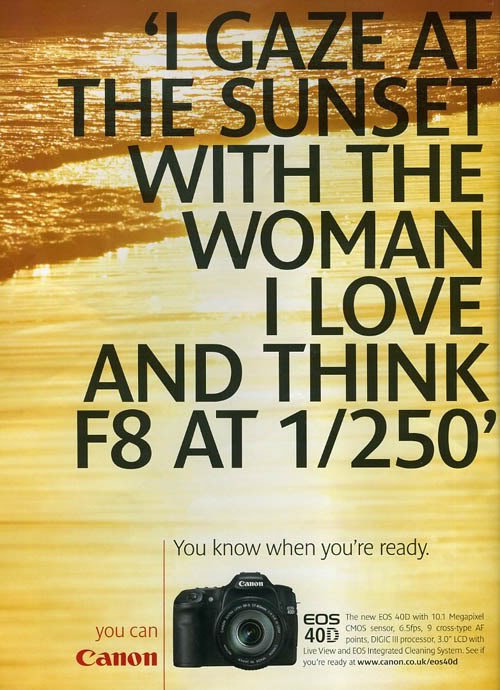First thing I thought of when I read this letter incidentally
Today for our Wednesday photography features, we’ll go into one of the questions I got in my inbox from one of our readers Aaron/animefreak2k4. He writes:
“I’m Aaron and I enjoyed reading your ‘back to basics’ articles on LYN. I’m quite a beginner in digital photography but i’ve just invested in a new DSLR. I got a Canon EOS 600D with Kit lens 18-55mm.
But the one thing that i really would like to know at this moment is that, is it enough for me to just stick to my Kit lens, or must i get more lens to suit different types of photo shooting? Will the kit lens be sufficient for most types of shooting? (eg. landscape, portrait, micro etc).
Also would be very happy if you can introduce some great websites that teaches digital photography for beginners.
Thanks a lot!
Aaron”
Thanks for your email Aaron and hit the jump for our reply!

This is a very common question to those who are just starting out with photography and unfortunately it is a very “chicken and the egg” conundrum. While it is good to have gear that suits what you want to shoot, it’s also prudent to master the basics before you get your Tilt Shift lens, macro lens and ring light or telephoto zoom lens.
Of course, that probably didn’t answer your question very well.
From what Aaron has said in his email as well as the info that he gave us, I would probably say that I would have probably gone for a faster 18-55mm equivalent from a third party manufacturer like this Tamron 17-50mm f/2.8, not everyone has a spare grand kicking around.
So in the spirit of saving money and working with what you have, here are some tips on how to maximize the usefulness of your kit lens!

The 600D is a pretty decent camera with specs you can be happy with. The kit lens however, is a different story. Most people will tell you to throw that kit lens in the bin, but sometimes that’s just not an option. To fully understand how to best make use of the kit lens, you must understand where it falls flat on its face compared to other lenses of its focal length.
The main folly of the kit lens is it is pretty damn slow. At f/3.5 – 5.6, short of pushing your ISO, you have very little you can do when it comes to low light photography, i mean, you can’t always lug a tripod around and get your subjects to be deathly still can you? How do you combat the fact that this kit lens is terrible in low light? Invest a little on a decent flash with a rotating head and diffuser.

This will be your first foray into making light when there is none to work with. Learn to bounce flashes off the ceiling and walls and how to use a bounce card. Master the art of flash power and how you adjust your camera settings with relation to the flash settings to get an optimum lighting condition. Who knows, soon you may actually want to try out off camera flash and take your first steps into the world of strobist style shooting! This will especially be beneficial when you take on portraits as you mentioned.

If you are looking to shoot things like landscapes, the most important item you will need is a tripod. Sure, ND filters and various other things will help too, but the point is, you can take some stunning landscape photos with your kit lens and a tripod. A photographer friend of mine has pictures on display that were taken with a very old Canon body and kit lens!
Another tip that I have for you is to learn to shoot in raw and get started on learning how do to post processing of your files. While it is perfectly acceptable to shoot in JPEG (god knows I shoot in JPEG sometimes) shooting in raw allows you to be in better control of things like White Balance and recovering from shadows and blown highlights. Of course it’s better to get things right on camera, but in the real world, we can’t always. Explore tools like Lightroom, Aperture, Adobe Camera Raw and Photoshop for this purpose.

So you want to shoot sports, high fashion or concerts? I’m sorry but you’re probably going to want to invest some money on a better lens then. While you can most definitely get by with a kit lens, you’re most likely going to be hindering your growth as a photographer by not using the right tools for the job.
That being said, the camera is just that, a tool for you to assist you in plying your craft, photography. To those people who say that gear is not everything, it’s true, it may not be everything, but it does help quite a bit. To those who say it’s all about the gear you use and the better gear you have, the better pictures you’ll take, it’s true, your pictures may be sharper, but let’s not call them necessarily better.
By the way, all the photos featured in this article are taken with a D40X or D90 with their respective kit lenses!
tl;dr: Make do with what you have and if you can afford it, upgrade for what you shoot most. It’s not all about gear, but having the right gear helps immensely.
Here are just some websites I will recommend for a beginner photographer:
http://photo.net/learn/
http://www.exposureguide.com/
http://www.luminous-landscape.com/
http://digital-photography-school.com/
It’s also worth reading Magazines like Digital Camera Magazine and Practical Photography.
If there are any more user questions, you can email me at lucas@lowyat.net or get me at @luc_sohow on twitter!
Follow us on Instagram, Facebook, Twitter or Telegram for more updates and breaking news.



